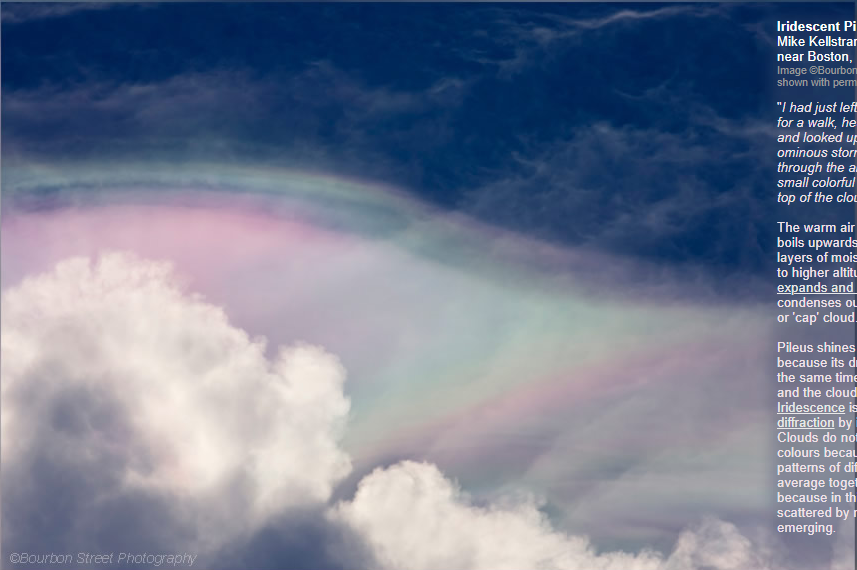Caps
Caps: Exploring the Colorful Phenomenon in the Sky
Have you ever looked up at the sky and been captivated by the sight of a colorful band at the top of a storm cloud? This intriguing phenomenon is known as a "cap" or pileus cloud. In this article, we will delve into the details of caps, uncovering the science behind their formation and the mesmerizing colors they exhibit.
When thunderstorms brew, warm air rises rapidly, carrying with it layers of moist air. As these layers are pushed to higher altitudes, they encounter a drop in temperature, causing the air to expand and cool. As a result, the moisture within the air condenses, forming a unique cloud formation called a pileus or cap cloud.
One of the striking features of pileus clouds is their vibrant colors. These colors are a result of a phenomenon known as iridescence. The droplets within the pileus cloud are formed at the same time and are similar in size, creating an ideal condition for diffraction to occur. When light passes through these droplets, it bends and scatters, resulting in the beautiful display of colors that we see.
While clouds typically appear white or gray due to the average diffraction patterns of droplets of different sizes, pileus clouds break this pattern. The thinness of these clouds allows individual droplets to diffract light more effectively, revealing the full spectrum of colors. However, it's important to note that this colorful display is only visible in thin cap clouds and not in thick clouds where light scatters through multiple droplets before emerging.
Understanding the science behind caps provides us with a deeper appreciation for these captivating atmospheric optics phenomena. Here are some key points to consider:
-
Cap Cloud Formation: Caps are formed when moist air is pushed to higher altitudes by rising warm air in thunderstorms. The cooling and condensation of this moist air result in the creation of thin, vibrant cap clouds.
-
Iridescence: The stunning colors observed in cap clouds are a result of iridescence, which occurs when light is diffracted by individual droplets within the cloud. The similar size of these droplets contributes to the distinct and vibrant display of colors.
-
Thin vs. Thick Clouds: Cap clouds are unique in their ability to showcase iridescence due to their thinness. In thick clouds, the diffraction patterns of droplets of varying sizes average together, resulting in a white or gray appearance.
-
Observing Caps: Spotting caps can be a thrilling experience. Keep an eye out for storm clouds and pay attention to the top of the cloud. If you notice a small, colorful band, you may have come across a pileus cloud.
-
Photographing Caps: Capturing the beauty of cap clouds through photography can be a rewarding endeavor. Experiment with different angles, lighting conditions, and camera settings to showcase the vibrant colors and intricate patterns.
-
Other Atmospheric Optics Phenomena: Caps are just one of the many fascinating atmospheric optics phenomena that can occur. Explore other wonders such as halos, rainbows, and sunsets to expand your knowledge and appreciation of the natural world.
As we gaze up at the sky, it's remarkable to witness the intricate and ever-changing displays that nature presents to us. Caps, with their vibrant colors and delicate formations, serve as a reminder of the awe-inspiring beauty that surrounds us. Take a moment to appreciate these captivating atmospheric optics phenomena and let them inspire you to delve deeper into the wonders of our atmosphere.

Iridescent Pileus imaged by Mike Kellstrand (Photography) near Boston, MA July 9, '08. Image ©Bourbon Street Photography, shown with permission.
"I had just left the house to go for a walk, heard some thunder, and looked up. There was an ominous storm cloud moving through the area and I spotted a small colorful bright band at the top of the cloud."
The warm air of thunder clouds boils upwards and pushes layers of moist air above them to higher altitudes. The air expands and cools, its moisture condenses out to form a pileus or 'cap' cloud.
Pileus shines with colour because its droplets, formed at the same time, are similar sized and the cloud is thin. Iridescence is the result of diffraction by individual droplets. Clouds do not usually reveal the colours because the diffraction patterns of different sized drops average together to white and because in thick clouds light is scattered by many drops before emerging.
Note: this article has been automatically converted from the old site and may not appear as intended. You can find the original article here.
Reference Atmospheric Optics
If you use any of the definitions, information, or data presented on Atmospheric Optics, please copy the link or reference below to properly credit us as the reference source. Thank you!
-
<a href="https://atoptics.co.uk/blog/caps-2/">Caps</a>
-
"Caps". Atmospheric Optics. Accessed on November 26, 2024. https://atoptics.co.uk/blog/caps-2/.
-
"Caps". Atmospheric Optics, https://atoptics.co.uk/blog/caps-2/. Accessed 26 November, 2024
-
Caps. Atmospheric Optics. Retrieved from https://atoptics.co.uk/blog/caps-2/.